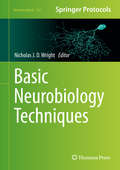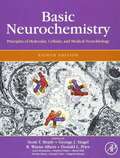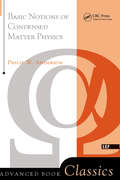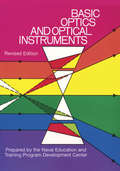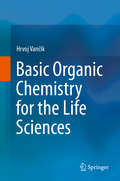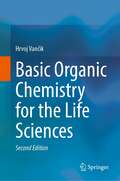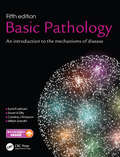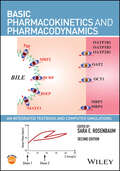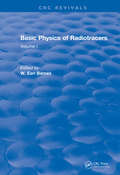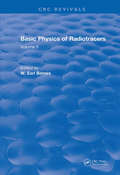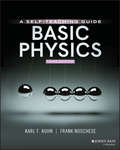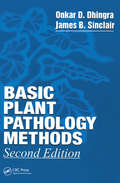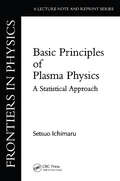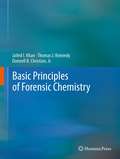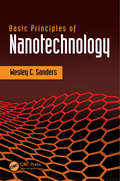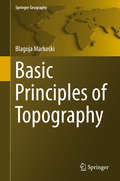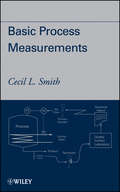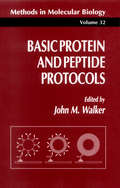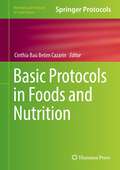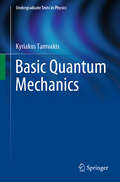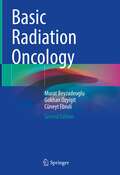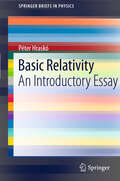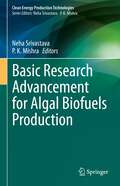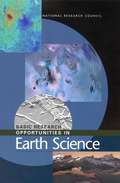- Table View
- List View
Basic Neurobiology Techniques (Neuromethods #152)
by Nicholas J. D. WrightThis volume explores the latest techniques and improved methods used to study important neurobiological and associated neuropathological conditions. Chapters cover topics such as the application of semiconductor quantum dots as photostable fluorophores used for labeling and tracking; GCaMP6 transcranial imaging to monitor neural activity; the patch-clamping technique allowing simultaneous monitoring of membrane currents and optical signals; and quantifying behavioral dysfunction caused by traumatic brain injury (TBI). In Neuromethods series style, chapters include the kind of detail and key advice from the specialists needed to get successful results in your laboratory.Cutting-edge and practical, Basic Neurobiology Techniques is a valuable resource for novel and expert researchers interested in expanding their knowledge of this developing field.
Basic Neurochemistry: Principles of Molecular, Cellular, and Medical Neurobiology
by Scott Brady Donald L. Price George Siegel R. Wayne AlbersBasic Neurochemistry, Eighth Edition, is the updated version of the outstanding and comprehensive classic text on neurochemistry. For more than forty years, this text has been the worldwide standard for information on the biochemistry of the nervous system, serving as a resource for postgraduate trainees and teachers in neurology, psychiatry, and basic neuroscience, as well as for medical, graduate, and postgraduate students and instructors in the neurosciences. The text has evolved, as intended, with the science. This new edition continues to cover the basics of neurochemistry as in the earlier editions, along with expanded and additional coverage of new research from intracellular trafficking, stem cells, adult neurogenesis, regeneration, and lipid messengers. It contains expanded coverage of all major neurodegenerative and psychiatric disorders, including the neurochemistry of addiction, pain, and hearing and balance; the neurobiology of learning and memory; sleep; myelin structure, development, and disease; autism; and neuroimmunology.
Basic Notions Of Condensed Matter Physics (Advanced Books Classics Ser.)
by Philip W. AndersonFirst Published in 2018. Routledge is an imprint of Taylor & Francis, an Informa company.
Basic Optics and Optical Instruments: Revised Edition
by Naval EducationDesigned as a training manual for Navy personnel (Opticalman 3 & 2), this book provides thorough coverage of the basic theory of optics and its applications. Newly revised and updated, it presents the subject matter with extraordinary clarity, stressing theory and application equally. It will serve admirably to supplement a course in which only one of these factors is emphasized.The book begins with an introduction to the Opticalman rating. It then goes on to discuss the characteristics of light, with special emphasis on wavelengths, reflection, and refraction. Two chapters contain a detailed discussion of the formation of images by mirrors, lenses, and prisms; these explain how images are formed by thin and thick lenses, how to use the lens formula, and how to determine the location of an image formed by an optical instrument. The mechanical construction, maintenance procedures, and machining operations of basic optical instruments are explained in detail, supplemented by chapters on maintenance procedures, basic instrument repair, machine shop practices, optical and navigation equipment maintenance, night vision sights and gunsights and submarine periscopes. A helpful four-part appendix includes a glossary, common formulae used in optical repair and machine operations, prefixes and symbols used in the metric system, and English and metric system units of measurement, with common equivalents and conversions. Profusely illustrated with 370 charts, diagrams, photographs, and drawings of tools and parts of instruments -- including cross-sections that reveal inner workings -- this manual is especially clear and well-organized. Although designed for use in U.S. Naval training schools, it can be used to great advantage as a basic text in optics in standard technical schools, and it will be immensely valuable even to the layman who desires a knowledge of the fundamentals of optics.
Basic Organic Chemistry for the Life Sciences
by Hrvoj VančikThis book is designed for students of biology, molecular biology, ecology, medicine, agriculture, forestry and other professions where the knowledge of organic chemistry plays the important role. The work may also be of interest to non-professionals, as well as to teachers in high schools. The book consists of 11 chapters that cover: - basic principles of structure and constitution of organic compounds, - the elements of the nomenclature, - the concepts of the nature of chemical bond, - introductions in NMR and IR spectroscopy, - the concepts and main classes of the organic reaction mechanisms, - reactions and properties of common classes or organic compounds, - and the introduction to the chemistry of the natural organic products followed by basic principles of the reactions in living cells.
Basic Organic Chemistry for the Life Sciences
by Hrvoj VančikThis textbook is designed for students of biology, molecular biology, ecology,medicine, agriculture, forestry and other professions where the knowledge of organic chemistry plays an important role. The work may also be of interest to non-professionals, as well as to teachers in high schools. The book consists of 13 chapters that cover the essentials of organic chemistry, including - basic principles of structure and constitution of organic compounds, - the elements of the nomenclature, - the concepts of the nature of chemical bond, - introductions in NMR and IR spectroscopy, - the concepts and main classes of the organic reaction mechanisms, - reactions and properties of common classes or organic compounds, - and the introduction to the chemistry of the natural organic products followed by basic principles of the reactions in living cells. This second edition includes revisions and suggestions made by the readers of the first edition and the author's colleagues. In addition, it includes substantial changes compared to the first edition. The chapter on Cycloaddition has been completed by including the other pericyclic reactions (sigmatropic rearrangements, electrocyclic reactions). The chapter on Organic Natural Products has been extended to include new section covering the principles of organic synthesis. New chapter "Organic Supramolecular and Supermolecular Structures" is added. This chapter covers the basic knowledge about the molecular recognition, supramolecular structures, and the mechanisms of the enzyme catalyzed reactions.
Basic Pathology: An introduction to the mechanisms of disease
by Sunil R. Lakhani Caroline J. Finlayson Susan A. Dilly Mitesh GandhiAn accessible and enjoyable introduction to pathology and the mechanisms of disease, this book puts pathology into its historical, scientific and clinical context. Organized in four main themes - What is a Disease, Defense Against Disease, Circulatory Disorders and Disorders of Cell Growth - the text highlights key mechanisms and their interplay in producing symptoms, signs and disease. Supplemented throughout with colorful cartoons, and much-praised clinical scenarios, this entertaining look at pathology offers historical anecdotes and helpful key-points boxes.
Basic Pharmacokinetics and Pharmacodynamics: An Integrated Textbook and Computer Simulations
by Sara E. RosenbaumUpdated with new chapters and topics, this book provides a comprehensive description of all essential topics in contemporary pharmacokinetics and pharmacodynamics. It also features interactive computer simulations for students to experiment and observe PK/PD models in action.* Presents the essentials of pharmacokinetics and pharmacodynamics in a clear and progressive manner* Helps students better appreciate important concepts and gain a greater understanding of the mechanism of action of drugs by reinforcing practical applications in both the book and the computer modules* Features interactive computer simulations, available online through a companion website at: http://www.uri.edu/pharmacy/faculty/rosenbaum/basicmodels.html* Adds new chapters on physiologically based pharmacokinetic models, predicting drug-drug interactions, and pharmacogenetics while also strengthening original chapters to better prepare students for more advanced applications* Reviews of the 1st edition: "This is an ideal textbook for those starting out ... and also for use as a reference book ...." (International Society for the Study of Xenobiotics) and "I could recommend Rosenbaum's book for pharmacology students because it is written from a perspective of drug action . . . Overall, this is a well-written introduction to PK/PD .... " (British Toxicology Society Newsletter)
Basic Phylogenetic Combinatorics
by Andreas Spillner Andreas Dress Katharina T. Huber Jacobus Koolen Vincent MoultonPhylogenetic combinatorics is a branch of discrete applied mathematics concerned with the combinatorial description and analysis of phylogenetic trees and related mathematical structures such as phylogenetic networks and tight spans. Based on a natural conceptual framework, the book focuses on the interrelationship between the principal options for encoding phylogenetic trees: split systems, quartet systems and metrics. Such encodings provide useful options for analyzing and manipulating phylogenetic trees and networks, and are at the basis of much of phylogenetic data processing. This book highlights how each one provides a unique perspective for viewing and perceiving the combinatorial structure of a phylogenetic tree and is, simultaneously, a rich source for combinatorial analysis and theory building. Graduate students and researchers in mathematics and computer science will enjoy exploring this fascinating new area and learn how mathematics may be used to help solve topical problems arising in evolutionary biology.
Basic Physics Of Radiotracers: Volume I (CRC Press Revivals)
by W. Earl BarnesThe opportunity to present the physics of radioactive processes in some detail apart from topics such as instrumentation which conventionally compete with it for spacer is most welcome. The material is intended to give a fairly complete introduction to radiation physics to those who which to have more than a descriptive understanding of the subject. Although it is possible to work one’s way through much of the subject matter without having any previous physics background, some prior acquaintance with modern physics is desirable. A familiarity with calculus and differential equations is also assumed. Volume I begins with a brief description of classical physics, it’s extension to special relativity and quantum mechanics, and an introduction to basic atomic and nuclear concepts. A thorough discussion of atomic structure follows with emphasis on the theory of the multielectron atom, characteristic X-rays, and the Auger effect. Volume II treats the subjects of nuclear structure, nuclear decay processes, the interaction of radiation with matter, and the mathematics of radioactive decay.
Basic Physics Of Radiotracers: Volume II (CRC Press Revivals)
by Lelio G. Colombetti W. Earl BarnesThe opportunity to present the physics of radioactive processes in some detail apart from topics such as instrumentation which conventionally compete with it for spacer is most welcome. The material is intended to give a fairly complete introduction to radiation physics to those who which to have more than a descriptive understanding of the subject. Although it is possible to work one’s way through much of the subject matter without having any previous physics background, some prior acquaintance with modern physics is desirable. A familiarity with calculus and differential equations is also assumed. Volume I begins with a brief description of classical physics, it’s extension to special relativity and quantum mechanics, and an introduction to basic atomic and nuclear concepts. A thorough discussion of atomic structure follows with emphasis on the theory of the multielectron atom, characteristic X-rays, and the Auger effect. Volume II treats the subjects of nuclear structure, nuclear decay processes, the interaction of radiation with matter, and the mathematics of radioactive decay.
Basic Physics: A Self-Teaching Guide (Wiley Self-teaching Guides #167)
by Karl F. Kuhn Frank NoscheseLearn physics at your own pace without an instructor Basic Physics: A Self-Teaching Guide, 3rd Edition is the most practical and reader-friendly guide to understanding all basic physics concepts and terms. The expert authors take a flexible and interactive approach to physics based on new research-based methods about how people most effectively comprehend new material. The book takes complex concepts and breaks them down into practical, easy to digest terms. Subject matter covered includes: Newton's Laws Energy Electricity Magnetism Light Sound And more There are also sections explaining the math behind each concept for those who would like further explanation and understanding. Each chapter features a list of objectives so that students know what they should be learning from each chapter, test questions, and exercises that inspire deeper learning about physics. High school students, college students, and those re-learning physics alike will greatly enhance their physics education with the help of this one-of-a-kind guide. The third edition of this book reflects and implements new, research-based methods regarding how people best learn new material. As a result, it contains a flexible and interactive approach to learning physics.
Basic Plant Pathology Methods
by James B. Sinclair Onkar Dev DhingraThe Second Edition of this bestseller brings together basic plant pathology methods published in diverse and often abstract publications. The Second Edition is updated and expanded with numerous new figures, new culture media, and additional methods for working with a greater number of organisms. Methods are easy to use and eliminate the need to seek out original articles. This reference allows for easy identification of methods appropriate for specific problems and facilities. Scientific names of pathogens and some of their hosts are updated in this edition. The book also acts as a research source providing more than 1,800 literature citations.The Second Edition includes chapters on the following:Sterilization of culture apparatus and culture mediaCulture of pathogens with detailed techniques for 61 fungi and selected bacteriaLong-term storage of plant pathogensDetection and estimation of inoculum for 28 soilborne fungal pathogens and 5 bacterial genera-15 methods for airborne inoculum and 13 methods for seedborne pathogensEstablishment of disease and testing for disease resistanceWork with soil microorganismsFungicide evaluationBiological controlBright-field microscopy
Basic Principles Of Plasma Physics: A Statistical Approach
by Setsuo IchimaruThe book describes a statistical approach to the basics of plasma physics.
Basic Principles of Forensic Chemistry
by Donnell R. Christian Jr. Thomas J. Kennedy Javed I. KhanThis book focuses on a marvel approach that blends chemistry with forensic science and is used for the examination of controlled substances and clandestine operations. The book will particularly interest forensic chemists, forensic scientists, criminologists, and biochemists.
Basic Principles of Nanotechnology
by Wesley C. SandersThe book allows the reader to have a basic understanding of the structure and properties of nanoscale materials routinely used in nanotechnology-based research and industries. To add, the book describes the operation of nanoscale transistors and the processes used to fabricate the devices. Additionally, it presents research involving the use of carbon nanotubes, graphene, and molecules to create non-silicon based electronic devices. It aims to provide an understanding of the operation of the most frequently used fabrication and characterization procedures, such as scanning electron microscopy, atomic force microscopy, etch, e-beam lithography, and photolithography.
Basic Principles of Topography (Springer Geography)
by Blagoja MarkoskiThis book gives a comprehensive overview of all relevant elements in topography and their practical application. It elaborates on the classical representation of terrain on maps such as cartographic projections, together with their classification, scale, and geographical elements. It is richly illustrated with photographs, maps and figures, in which the theoretical explanations are clarified. Readers will become acquainted with the physical characteristics of the ground, i. e. tectonic and erosive shapes, the importance and classification of terrain, genetic (fluvial, abrasive, glacial, karst) and topographic types such as higher (mountains, hills, peaks) and lower terrain (valleys, fields). In addition, the book discusses cartometry and coordinate systems, orientation in space (geographic, topographic, tactical) including by means of maps, instruments and the night sky and elaborates new techniques and technologies such as aerial photogrammetric imagery, global navigation satellite systems and LiDAR. The book also includes methods for the practical execution of concrete measurement operations, such as determining position and movement on land with maps, compass and azimuth which makes it especially useful for practitioners and professionals, e. g. , for landscape planning, military exercises, mountaineering, nature walks etc. As such it offers a valuable guide not only for undergraduate students but also for researchers in the fields of geography, geosciences, geodesy, ecology, forestry and related areas looking for an overview on topography. Uniquely, the book also features an extensive glossary of topographical terms.
Basic Process Measurements
by Cecil L. SmithA unique resource for process measurementBasic Process Measurements provides a unique resource explaining the industrial measuring devices that gauge such key variables as temperature, pressure, density, level, and flow. With an emphasis on the most commonly installed technologies, this guide outlines both the process variable being measured as well as how the relevant measuring instruments function. The benefits of each technology are considered in turn, along with their potential problems. Looking at both new and existing technologies, the book maintains a practical focus on properly selecting and deploying the best technology for a given process application.The coverage in Basic Process Measurements enables the practitioner to: Resolve problems with currently installed devices Upgrade currently installed devices to newer and better technologies Add instruments for process variables not previously measurable Evaluate device installations from a perspective of both normal process operating conditions and abnormal conditions Determine the best technology for a given set of process conditions Designed for a wide range of technical professionals, Basic Process Measurements provides a balanced treatment of the concepts, background information, and specific processes and technologies making up this critical aspect of process improvement and control.
Basic Protein and Peptide Protocols (Methods in Molecular Biology #32)
by John M. WalkerBasic Protein and Peptide Protocols offers an excellent collection of reproducible, step-by-step laboratory methods covering three major areas: (1) the quantitation and characterization of proteins, (2) the electrophoretic and blotting procedures used in protein isolation and characterization, and (3) the analysis of protein and peptide structure. THOUSANDS of labs are already using Basic Protein and Peptide Protocols-you should be too!
Basic Protocols in Foods and Nutrition (Methods and Protocols in Food Science)
by Cinthia Baú Betim CazarinThis book provides comprehensive knowledge and a detailed step by step description of experimental protocols for the determination of food intake, body weight changes, and some metabolic markers. Chapters are split into two parts detailing experimental diets, monitor food intake, weight gain, evaluate biological samples, predict physiological changes, evaluate bioavailability of bioactive, anamnesis, measure the metabolic rate, assessing the body composition, assessing glucose homeostasis, and monitoring the metabolomic pathways. Authoritative and cutting-edge, Basic Protocols in Foods and Nutrition aims to be a foundation for future studies and to be a source of inspiration for new investigations in the field.
Basic Quantum Mechanics (Undergraduate Texts in Physics)
by Kyriakos TamvakisThis textbook on quantum mechanics has been designed for use in two-semester undergraduate courses. It describes the basic concepts of quantum mechanics, explains the use of the mathematical formalism and provides illustrative examples of both concepts and methods. Although the aim is to enable students to master the use of quantum mechanics as a tool, the author also discusses the meaning of quantum concepts. To this end the book contains a variety of relevant examples, worked out in considerable detail, as well as a substantial number of pertinent problems and exercises. The latter will be extremely helpful, if not essential, for gaining a deep understanding and command of the subject. This book is based on the author's thirty years experience of teaching the subject.
Basic Radiation Oncology
by Gokhan Ozyigit Murat Beyzadeoglu Cüneyt EbruliThis practical, up-to-date, bedside-oriented radiation oncology book encompasses the essential aspects of the subject with coverage on radiation physics, radiobiology, and clinical radiation oncology. The first two sections examine concepts that are crucial in radiation physics and radiobiology. The third section describes radiation treatment regimens appropriate for the main cancer sites and tumor types.
Basic Relativity: An Introductory Essay (SpringerBriefs in Physics)
by Péter HraskóThis Brief presents a new way of introducing relativity theory, in which perplexing relativistic effects such as time dilation and Lorentz contraction are explained prior to the discussion of Lorentz-transformation. The notion of relativistic mass is shown to contradict the spirit of relativity theory and the true significance of the mass-energy relation is contrasted with the popular view of it. The author discusses the twin paradox from the point of view of both siblings. Last but not least, the fundamentals of general relativity are described, including the recent Gravity Probe B experiment.
Basic Research Advancement for Algal Biofuels Production (Clean Energy Production Technologies)
by P. K. Mishra Neha SrivastavaThe edited book presents sustainable adopting options in basic research for improving algal biofuels production. This book is probably first book on algal biofuels which is focused on improving the primary basic research to enhance mass scale technological production of algal biofuels. The book explores significance of basic bench top research to increase pilot scale production of algal biofuels. The books also targeting the most sustainable and economical algal biofuels option with in depth details. Further, it highlights the existing roadblock, their analysis and eco-friendly solution to control them in most greenery way. This book is highly useful for academician, researchers and industries professionals and of high interest for students of bioenergy, sustainable practices and renewable energy.
Basic Research Opportunities in Earth Science
by National Research CouncilThe Committee concludes that the National Science Foundation, through its Earth Science Division is the only federal agency that maintains significant funding for basic research in all the core disciplines of Earth science, and is therefore central to the discipline's national effort. Rather than reviewing existing Division programs, the report identifies new research areas that could be added to its solid-Earth and hydrology portfolio. It is not indexed. Annotation c. Book News, Inc. , Portland, OR (booknews. com)
